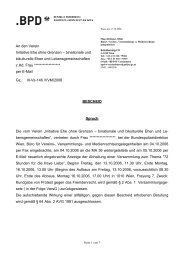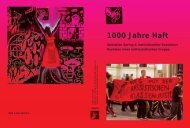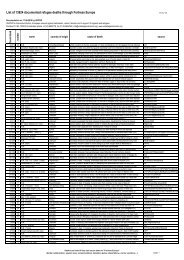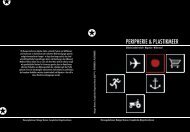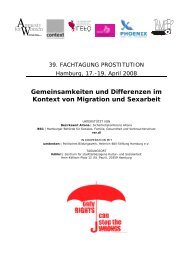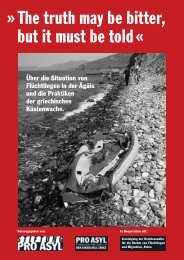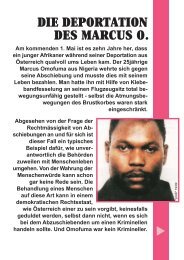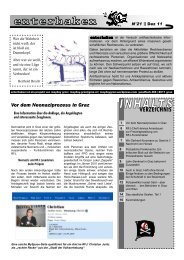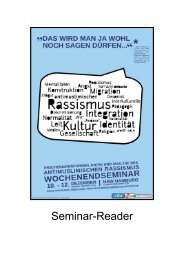Turin's CIE - International University College of Turin
Turin's CIE - International University College of Turin
Turin's CIE - International University College of Turin
Create successful ePaper yourself
Turn your PDF publications into a flip-book with our unique Google optimized e-Paper software.
VII. RELATIONSHIPS BETWEEN DETAINEES<br />
1. INAPPROPRIATE MIX - GROUPING PEOPLE COMING FROM JAIL AND<br />
ASYLUM SEEKERS, YOUNG AND VULNERABLE PEOPLE<br />
In <strong>Turin</strong>’s <strong>CIE</strong>, all detainees <strong>of</strong> the same gender are grouped together, regardless <strong>of</strong> age,<br />
language or whether they are ex-prisoners or asylum seekers escaping trauma and conflict 96 .<br />
The United Nations High Commissioner for Refugees and the Inter-Parliamentary Union’s<br />
Committee on Parliamentary, Judicial and Human Rights Questions have advised governments<br />
that it is important that “recognition <strong>of</strong> physical and psychological traumas many asylum<br />
seekers have experienced, should be taken into account when considering any restrictions on<br />
their freedom <strong>of</strong> movement” 97 . Yet, for asylum seekers in <strong>Turin</strong>’s <strong>CIE</strong>: “The culture inside <strong>CIE</strong> is<br />
similar to the culture <strong>of</strong> a jail. You <strong>of</strong>ten find the same dynamics both in jail and in <strong>CIE</strong>. There is no<br />
attention on dividing those who come from jail from those who have never had any contact with<br />
jail” (Interview 28). Another lawyer defined the mixed nature <strong>of</strong> <strong>CIE</strong> as one <strong>of</strong> the main problems<br />
about how <strong>CIE</strong> is structured: “There are no divisions based on cultural zones <strong>of</strong> arrival, or in<br />
relation to ex-<strong>of</strong>fenders. This creates some vulnerability and the construction <strong>of</strong> hierarchies in<br />
different areas. If we place an individual victim <strong>of</strong> trafficking with an asylum seeker in a mixed<br />
area, these people will potentially be subjected to further abuse” (Interview 5).<br />
2. ETHNIC OR CULTURAL ISSUES AND TENSIONS<br />
Detainees live under immense stress since there is a constant overhanging uncertainty about<br />
how long they will remain in detention and what country they will live in once free. There were<br />
very mixed perspectives about relationships between detainees. An evaluation <strong>of</strong> relationships<br />
between detainees must consider the pressure <strong>of</strong> sharing a cell with up to six other people with<br />
very limited personal space or activities:<br />
“Living together is not easy. Sometimes everything is fine, sometimes someone loses his<br />
temper because <strong>of</strong> this situation. Sometimes it becomes unbearable and you go out <strong>of</strong> your<br />
mind. So there may be tensions and fights. But you should be clever enough to understand<br />
the other people and to avoid fights among each other” (Interview 20).<br />
The restrictive <strong>CIE</strong> environment can exacerbate tensions: “there have been some fights over food”<br />
(Interview 11). Moreover, there is a diverse cultural, linguistic and religious mix in this<br />
constrained physical space:<br />
“Relationships are difficult. Usually people who come from one country are together<br />
because <strong>of</strong> nationality, religion, etc. There can be problems with people coming from other<br />
countries. But if they [detainees] are kept in different sections, they [the problems] are<br />
limited. Probably, there are quarrels because there are so many people inside”<br />
(Interview 7);<br />
“Well, between the detainees, yes. I saw one or two who were Moroccans, they had fought a<br />
day before. And also another time, a Senegalese had a fight with a Moroccan. One or two<br />
96 “Detainees are all together: young boys coming from Lampedusa with former convicts with asylum seekers.<br />
They are only more or less divided in different rooms according to their nationality, that’s all” (Interview 2).<br />
97 United Nations High Commissioner for Refugees and the Inter-Parliamentary Union’s Committee on<br />
Parliamentary, Judicial and Human Rights Questions, Refugee Protection: A Guide to <strong>International</strong> Refugee<br />
Law (2001), 81.<br />
56 | P a g e




